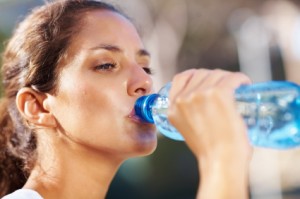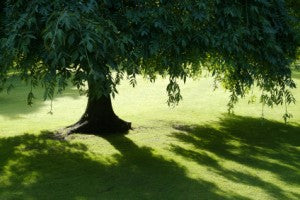
The dangerous effects of unusually high temperatures on the human body fall into three types: Heat Cramps, Heat Exhaustion, and Heat Stroke. For some, such as outdoor sports enthusiasts, construction or road crews, farmers, ranchers, etc., the heat may come from the sun. For others, industrial settings such as steel mills, bakeries, boiler rooms, laundries, mines, and factories may be the heat source. Extreme heat also results from burning buildings or wildfires which affect both firefighters and residents. All are at risk.
Heat cramps are muscle spasms caused by the loss of salt and potassium through heavy perspiration. Often the lost water gets replaced, but the necessary minerals (potassium and sodium) do not. Cramps may affect the legs, arms, or stomach.
- Cramping may occur while the person is still engaged in strenuous activity—such as athletes who collapse with cramps while competing, or the cramps may suddenly occur several hours later when they are relaxing or sleeping.
- Although painful and temporarily debilitating, cramps do not usually result in permanent damage. Treatment options include gently massaging the affected muscle, manipulating the limb, and trying to stand on cramping legs.
- To prevent cramps, drink both water and electrolyte solutions (sports drinks) during the day and eat more potassium-rich foods like bananas; orange juice; avocado; nuts and seeds; dried apricots, prunes, dates, and raisins; baked potatoes; and dark chocolate.
Heat Exhaustion is more serious than cramping and happens when the body’s internal cooling system becomes overworked but hasn't completely shut down. Surface blood vessels and capillaries which normally enlarge to cool the blood actually collapse from loss of fluids and minerals.
Heat Exhaustion occurs when you don’t drink enough fluids to replace what you’ve lost. This is especially easy to do in hot, dry, and breezy/windy conditions; you may not be aware of how much you’re perspiring because the sweat evaporates so quickly. Symptoms include:
- Headache
- Increased perspiration
- Intense thirst
- Dizziness
- Fatigue
- Loss of coordination
- Nausea
- Hyperventilation
- Tingling in the hands and feet
- Cool and moist skin
- Impaired judgment
- Loss of appetite
- Weak and rapid pulse (120-200 beats per minute)
- Anxiety
- Below-normal blood pressure
Treatment of heat exhaustion includes moving the affected person to a cooler place—into the shade or an air-conditioned building—and having him lie down with feet slightly elevated. Loosen their clothing, apply cool, wet cloths, and fan them. Have them sip sports drinks or water. Have them checked by medical personnel. They should avoid strenuous activity for at least a day and drink plenty of liquids.
 Heat stroke
Heat stroke is a life-threatening condition with a high death-rate which occurs when the body has completely depleted its supply of water and salt, raising the core temperature to deadly levels.
The victim may progress to this dangerous condition through the stages of heat cramps and heat exhaustion, but not always. Sometimes the onset is sudden, especially if the heat is extreme. Heat stroke is often mistaken for a heart attack, especially in the workplace. Know the symptoms of heat stroke and check for them anytime a person collapses in a hot environment.
- A high body temperature (103° F or higher)
- Absence of perspiration
- Hot, red, dry skin
- Rapid pulse
- Difficulty breathing
- Constricted pupils
- Any signs of extreme heat exhaustion—dizziness, nausea, confusion, slurred speech, bizarre behavior, collapse
- Hallucinations
- Loss of consciousness
- High blood pressure
- Sudden spiking of the temperature to 108° F
- Seizure or convulsions
- Death
Seconds count in saving the person’s life. If you suspect heat stroke, act immediately to reduce the victim’s core temperature and get them rehydrated.
- Call 9-1-1 right away
- Pour water on the victim
- Loosen or saturate their clothing
- Fan them
- Get them to a cooler place (like the shade under a tree or pavilion)
- Apply cold packs
 PREVENTING HEAT DAMAGE:
PREVENTING HEAT DAMAGE:
- If you know you’re going to be working or playing in extremely hot temperatures, condition yourself ahead of time by starting slowly and building up to more strenuous levels of activity. Allow a few days for your body to adjust.
- Drink a little more than you think you need; don’t wait until you feel thirsty!
- Use both water and sports drinks, consuming about one cup of liquid every 15-20 minutes in very hot conditions.
- Avoid alcohol or caffeinated beverages like coffee, tea, or soda pop. Caffeine contributes to dehydration. Alcohol is a diuretic as well—and the symptoms of a hangover are actually those of dehydration. If you use any of these beverages, compensate for them by drinking additional water.
- Do not consume huge amounts of water (or any liquid) all at once in an effort to rehydrate your body—you can overload your kidneys and cause more problems than you’re solving. Drink slowly.
- If you begin to feel faint or develop a headache, take a break, drink some water, and cool off before getting back to your activity.
- Wear lightweight, light-colored clothing, take advantage of fans and air-conditioners, and get plenty of sleep. Try to perform your most strenuous and difficult tasks during the coolest hours of the day.
- People who are over 65, overweight, have high blood pressure or heart disease, or are taking diuretics are the most vulnerable to heat-stress conditions, but no one is immune.
- Pregnant women, especially during the first trimester, should not have a core temperature higher than 102.2° F for extended periods, as there is a risk for malformations in the developing fetus. A perpetual core temperature above 100.4° F. in both males and females is associated with temporary infertility.
HEAT SYNCOPE is fainting or extreme lightheadedness that usually occurs with prolonged standing or suddenly rising from a sitting or lying position in hot conditions. This happens because blood pools in the extremities rather than returning to the heart to be pumped to the brain. Contributing factors include dehydration and lack of acclimation to the conditions. Treatment is to sit or lie down, then slowly drink water, clear juice, or a sports beverage. After recovery, moving around will help to prevent a recurrence.
HEAT RASH, or “prickly heat,” is a skin irritation characterized by clusters of red pimples or small blisters on the neck, upper chest, in the groin area, under the breasts, and in elbow or knee creases. Gently cleanse the affected area, pat dry, and allow to “air out.” Use dusting powder to increase comfort. If possible, try to move to a cooler, drier area.
Knowing a few basics about the prevention and treatment of heat-stress conditions can prevent a lot of discomfort, illness, and even—in the most extreme cases—death. Use the knowledge you've gained here and your common sense to keep safe and hydrated when working or playing in the heat. Stay cool!
Sources:
www.emedicinehealth.com/heat_stroke/article_em.htm
www.bnl.gov
www.dehydration.net
www.cdc.gov/niosh/topics/heatstress/

 Heat stroke is a life-threatening condition with a high death-rate which occurs when the body has completely depleted its supply of water and salt, raising the core temperature to deadly levels.
The victim may progress to this dangerous condition through the stages of heat cramps and heat exhaustion, but not always. Sometimes the onset is sudden, especially if the heat is extreme. Heat stroke is often mistaken for a heart attack, especially in the workplace. Know the symptoms of heat stroke and check for them anytime a person collapses in a hot environment.
Heat stroke is a life-threatening condition with a high death-rate which occurs when the body has completely depleted its supply of water and salt, raising the core temperature to deadly levels.
The victim may progress to this dangerous condition through the stages of heat cramps and heat exhaustion, but not always. Sometimes the onset is sudden, especially if the heat is extreme. Heat stroke is often mistaken for a heart attack, especially in the workplace. Know the symptoms of heat stroke and check for them anytime a person collapses in a hot environment.
 PREVENTING HEAT DAMAGE:
PREVENTING HEAT DAMAGE:
